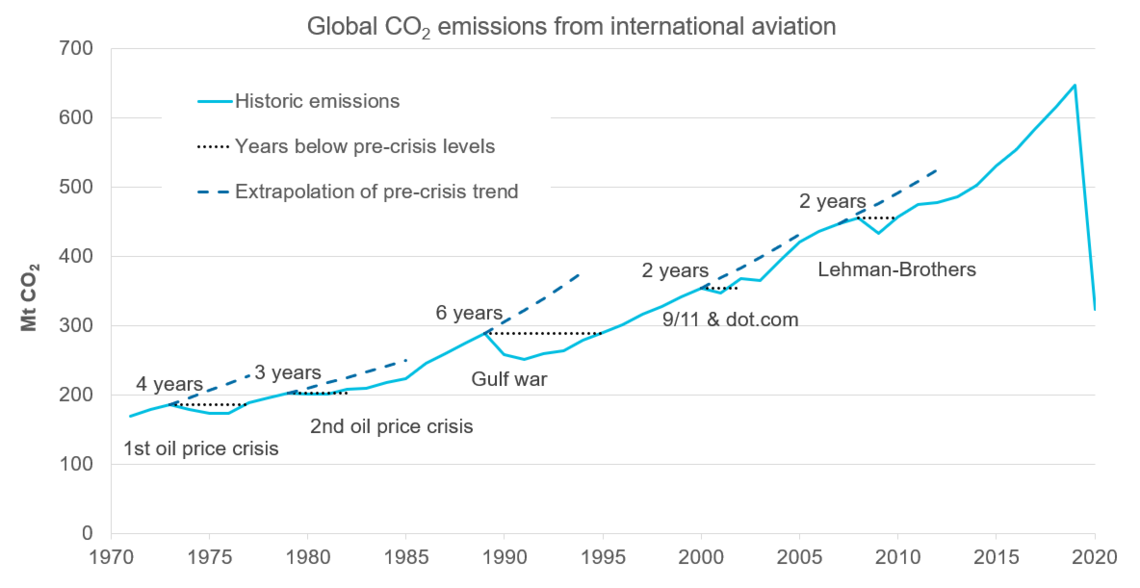Future development of aviation
Forecasted development of aviation
The number of passengers and emissions from aviation have grown almost continuously up to now. Between 2013 and 2018 alone, emissions increased by 5% annually. Forecasts made prior to the Covid-19 pandemic show this growth continuing in the future. For example, experts predicted that the passenger kilometres travelled would continue to grow by over 4% per year. This means that there would be almost four times as much air transport worldwide in 2050 as in 2015.
However, the passenger shares in air transport are very unevenly distributed, both among income groups and regions. This, higher growth rates are expected for Asia and especially emerging countries with growing middle classes than for industrialized countries.
Energy consumption and efficiency
The International Civil Aviation Organization ICAO forecasts that kerosene consumption will increase by a factor of 2.4 to 3.8 by 2050 compared to 2015, depending on how much more efficient aircraft become. Although consumption in terms of passenger kilometres flown has fallen significantly in recent decades, levels of air transport are growing much faster than efficiency. Even under the most optimistic assumptions for technological developments and efficiency improvements, ICAO expects only a 1.37% annual reduction in fuel consumption in transport volume up to 2050.
Impact of Covid-19 on aviation
The Covid-19 pandemic led to an unexpected, drastic and unprecedented decrease in air transport in 2020. As of autumn 2020, it is expected that fewer than half as many airplanes were in the air in Germany, in the EU, and globally in 2020 compared to 2019.
In autumn 2020, the end of air travel restrictions due to the pandemic is not yet in sight. Will the development of a vaccine cause people worldwide to return to their old travel patterns? Or will the crisis also lead to fewer passenger numbers in the long run? These are important questions that are still unanswered.
In the past, too, there were events and crises that caused the CO₂ emissions of international air transport to fall – such as the economic crisis of 2007 and 2008, the effects of the 2001 terrorist attacks or the Second Gulf War in the early 1990s. But after these crises, aviation levels returned to pre-crisis levels within two to six years. Moreover, within a few years, they returned to the growth levels that existed before the crisis, albeit with emissions that were somewhat lower overall. Projections made in autumn 2020 similarly showed the volume of air travel measured in passenger kilometres travelled returning to 2019 levels within five years.

At the same time, individual voices are sketching a scenario in which the crisis could lead to lower growth rates in aviation in the long term than in the past. Factors that could contribute to this are:
-
Less travel after the end of the pandemic, e.g. because business trips continue to be increasingly substituted by virtual meetings. However, the pandemic alone will not fundamentally change our private travel behavior; stronger rethinking is needed for that to happen.
-
Making financial support to the aviation industry conditional on a reduction of air travel emissions that harmful to the climate. So far, however, only two countries – France and Austria – have imposed such conditions as non-binding requirements for financial aid.
-
Using the most efficient aircraft when air transport is resumed. However, as long as the technological developments to increase energy efficiency are slow, emissions will rise again.
In autumn 2020, the global network Air Transport Action Group (ATAG) predicted that about 10 billion passengers per year will travel by air in 2050. That’s more than double the number in 2019, but 16% below previous forecasts due to the impact of the Covid-19 pandemic.
Ways forward for climate protection after the pandemic
However, an instrument that was supposed to ensure more climate protection in aviation has become significantly less effective as a result of the Covid-19 pandemic. In June 2020, ICAO adjusted the rules for the CORSIA agreement: by changing the reference value against which airlines must offset their emissions growth in the future, the demand for offset credits will drop sharply in the years ahead. This will make the instrument almost ineffective in terms of climate protection.
In our view, reconstruction after the Covid-19 pandemic should be taken as an opportunity to make the aviation sector greener through regulations geared to increasing climate protection, stronger requirements for emission reduction and the use of alternative fuels, the promotion of technological innovations and the avoidance of air travel. By all means, we should not return to unchecked aviation growth.
Links
-
Heinrich-Böll-Stiftung (2016): Oben. Ihr Flugbegleiter.
-
Roland Berger (2020): Covid-19 – How we will need to rethink the aerospace industry.
-
IATA (2020): Covid-19: Outlook for air travel in the next 5 years.
-
ICAO (2018): ICAO long-term traffic forecasts. Passenger and cargo.
-
ICAO (2019): Destination Green: The next chapter. 2019 Environmental Report Aviation and Environment.
-
ICAO (2019): Trends in emissions that affect climate change.
-
ICAO (2020): Economic impacts of Covid-19 on civil aviation.
-
Infras (2018): Szenario Luftverkehr Deutschland unter Einbezug von Umweltaspekten. Umweltbundesamt.